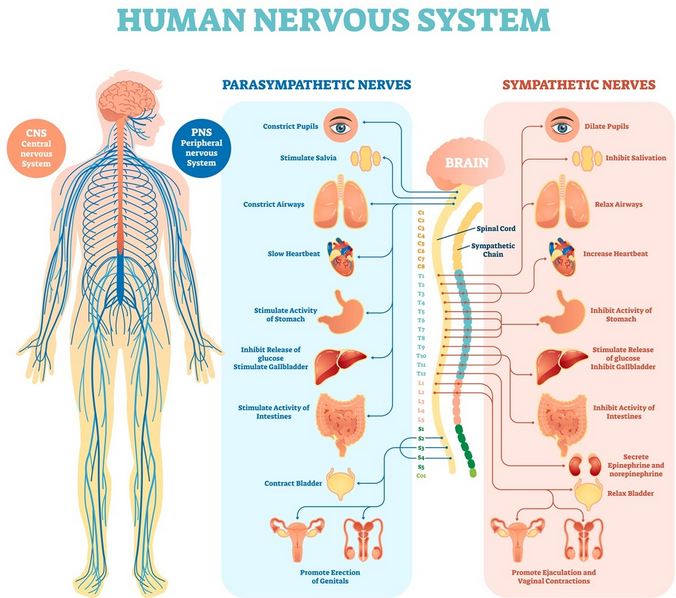In this post, we’ll take a look at how the Nervous System works, and how understanding it can be helpful to our health, wellness, and optimal functioning.

The Autonomic Nervous System is divided into two branches. You may be familiar with the Sympathetic and Parasympathetic Branches of the autonomic nervous system. The Sympathetic Nervous System governs our “fight/ flight” response, and mobilizes us into action. The Parasympathetic Nervous System helps us to settle, reorganize, and “come down” from an activated state.
But did you know that the Parasympathetic Branch has two distinct channels, which operate in very different ways?
The “Ventral Vagal” branch of the Parasympathetic Nervous System is the more highly evolved part. The nerve branches are mylineated (covered in healthy fat) which allows the nerve impulses to travel gently, smoothly, and easily throughout the body. This channel governs the relaxation response. It’s also the state we’re in when we’re learning something new, as well as the state of social engagement. (Think about how good it feels when you are around people you love and you feel safe and good. This is the state of the Ventral Vagal, the easy, resting, relaxed state of healthy engagement and social interaction).
The “Dorsal Vagal” is the more primitive branch of the Parasympathetic System. As part of its functioning, it includes the quick ” shutdown” response.
If there is an extremely high level of arousal, this will trigger a shutdown. This is also known as a “freeze”, or immobility state. We see examples of this in animals in the wild who mercifully go into a shutdown response in times of acute stress or pain. (The Dorsal Vagal System is also responsible for some of the “rest/ digest” functions of the body).
The Sympathetic Nervous System gets us ready for action. The Parasympathetic System brings us down from the active response. This will either happen through the easy, slow, gentle response of the ventral vagal or the quick shutdown response of the dorsal vagal.
As humans, we need all three states. In a healthy nervous system, these three states operate fluidly and flexibly, supplying appropriate responses in each moment. The sympathetic nervous system mobilizes the “fight or flight” response, and the parasympathetic nervous system brings the body back down to a resting state once the “threat” has passed. However, if there is an extremely high level of sympathetic arousal, this may trigger a “freeze” response.
Understanding the branches of our nervous system and how they work sets us up to be able to work with and guide our nervous system into its healthiest and most optimal functioning. In the next blog, we’ll look at how the nervous system gets out of whack (and what that looks like). As we get to know our own systems and how they operate, we’re able to better support our own healthy regulation for our most optimal health and well-being.
Read more about how trauma affects the body.




